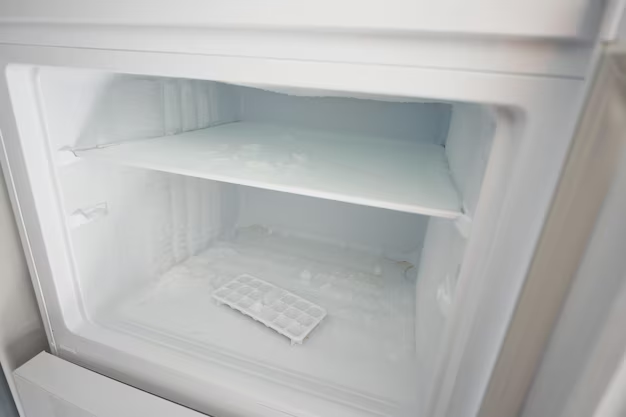Why Does Your Refrigerator Keep Freezing Up? A Comprehensive Guide to Prevention and Solutions
Have you ever reached for a favorite snack in your fridge only to find it's turned into a block of ice? If your refrigerator has been doubling as a makeshift freezer, it's time to find out why and how to fix it. This article delves into the reasons behind this frosty nuisance while providing step-by-step guidance to keep your food both chilled and unspoiled.
Understanding the Basics: How Does a Refrigerator Work?
Before we address the problem, it's essential to understand how your refrigerator functions. A refrigerator cools its compartments through a combination of components including a compressor, condenser coils, evaporator coils, and a thermostat. Together, these parts maintain a consistent temperature that, ideally, keeps your food cool but not frozen.
Key Components
- Compressor: Compresses refrigerant and circulates it through the coils.
- Condenser Coils: Release heat from the refrigerant.
- Evaporator Coils: Absorb heat inside the fridge, maintaining cool temperatures.
- Thermostat: Regulates the fridge's internal temperature.
Why Your Refrigerator May Be Freezing Up
Several factors can cause your refrigerator to turn into an icicle-making machine. Identifying the root cause is the first step to finding a solution.
Incorrect Temperature Settings
One of the most common reasons for a refrigerator freezing is an overly low temperature setting.
- Solution: Adjust the temperature settings. Most refrigerators work well at a temperature of about 37°F for the fridge and 0°F for the freezer. If your fridge is too cold, try increasing the temperature gradually.
Faulty Thermostat
A malfunctioning thermostat can lead the compressor to run continuously, making the refrigerator too cold.
- Solution: Test and replace the thermostat if necessary. Use a multimeter to determine if the thermostat is working correctly. If it's faulty, replacing it could resolve the issue.
Blocked Air Vents
Improperly stored food can block the air vents inside the refrigerator, leading to uneven cooling.
- Solution: Reorganize your refrigerator. Ensure that vents are clear of any obstructions to allow proper airflow. Regularly check and rearrange items as needed.
Defective Door Seal (Gasket)
The door seal ensures that cold air stays inside the fridge. A broken or loose seal can cause the internal temperature to drop excessively.
- Solution: Inspect the door gasket. Look for gaps or damage to the seal. If needed, replace the gasket to maintain proper insulation.
Problematic Defrost System
In fridges with automatic defrost systems, a failure can lead to ice buildup, affecting temperature regulation.
- Solution: Check the defrost system. This includes inspecting the defrost heater, timer, and thermostat. Replacing any defective components can help restore normal function.
Malfunctioning Temperature Sensor
A sensor that's not working ideally might lead to inaccurate adjustments to the compressor's runtime.
- Solution: Test the temperature sensor. Use a multimeter to confirm its operation. If it's broken, replace it.
Preventive Measures to Avoid Freezing Issues
Taking preventive action is crucial to stop recurring freezing problems in your refrigerator.
Regular Maintenance
- Clean Coils: Dirty condenser coils can cause the refrigerator to work harder than necessary. Clean them at least twice a year.
- Check Seals: Regularly inspect door seals for signs of wear and tear. Replace as needed to keep the appliance efficient.
Proper Storage
- Organize Efficiently: Don’t overfill the fridge; there should be space for air to circulate freely.
- Position Wisely: Place the refrigerator away from direct sunlight and heat sources, which can affect its performance.
Routine Temperature Checks
- Regularly Monitor Temperatures: Use a fridge thermometer to keep an eye on the internal temperature and make adjustments as necessary.
Troubleshooting Common Issues
Still noticing a problem? Here are a few simple troubleshooting steps.
Issue: Uneven Cooling
- Check the vents for blockages.
- Inspect the fan motor: Ensure it's running smoothly.
Issue: Ice Buildup
- Examine the defrost system for faults.
- Defrost manually if excessive ice forms.
Easy Repair Tips
- Adjust the thermostat slowly, observing any changes.
- Replace broken components like seals or thermostats upon confirming their malfunction.
When to Call a Professional
Sometimes, despite your best efforts, a refrigerator may necessitate expert intervention.
Signs You Need Help
- Persistent freezing despite adjusting settings.
- Unusual noises or odors from the appliance.
- Consistent problems with the defrost system.
Table: Quick Troubleshooting Tips
| Problem | Possible Cause | Recommended Action |
|---|---|---|
| Freezing Items | Low Thermostat Setting | Adjust temperature setting |
| Uneven Cooling | Blocked Vents | Clear air vents |
| Ice Buildup | Faulty Defrost System | Check and repair defrost parts |
| Continuous Running | Malfunctioning Thermostat | Test/replace the thermostat |
Summary & Takeaways 🌟
- ⚡ Adjust thermostat settings to find the optimal temperature.
- 🌬️ Ensure clear airflow by maintaining organized storage.
- 🔍 Regular inspections of gaskets and defrost systems prevent major issues.
- 🌡️ Periodic temperature checks help maintain refrigerator performance.
- 👨🔧 Seek professional help when problems persist despite troubleshooting efforts.
By following these easy steps, general maintenance, and timely inspections, you'll likely find that your refrigerator returns to its optimal chilling, rather than freezing, performance. With the right care, your fridge can efficiently keep your food fresh, enhancing not only your food storage but also ensuring an extended shelf life and better quality of your food products.
